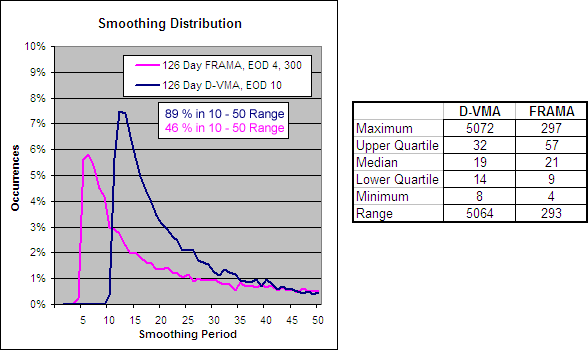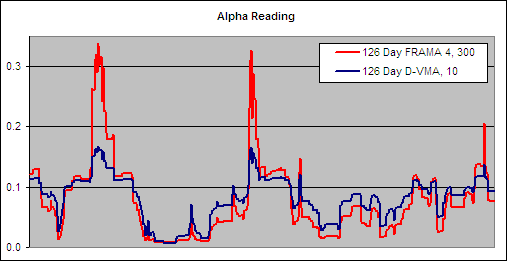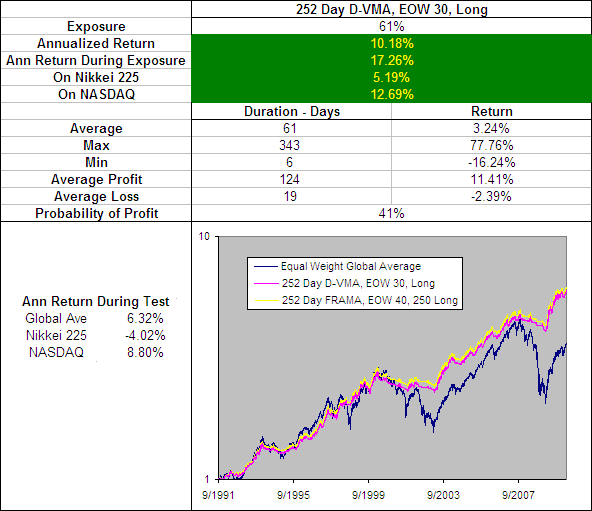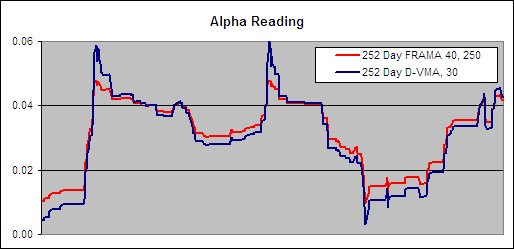The Adaptive Moving Average (AMA) modifies the amount of smoothing it applies to data in an attempt to adjust to the changing needs of a dynamic market. It makes these adjustments based on the readings from a Volatility Index (VI). Any measure of volatility or trend strength can be used, however in this article we will focus on how the AMA performs using the Fractal Dimension (D). This is the VI used in the FRAMA which has so far been the best performing Moving Average we have tested.
We did have to make one slight modification to the Fractal Dimension however. The Volatility index in an AMA needs to shift through a 0 – 1 range where higher readings indicate a stronger trend. The Fractal Dimension shifts through a 1 – 2 range where lower readings indicate a stronger trend. Therefore we shall use = ABS(D – 2).
The D-AMA requires four user selected inputs: A Fractal Dimension Period, a High – Low smoothing period range for the AMA and a power that Alpha is raised to. We tested trades going Long, using Daily data, taking End Of Day (EOD) and End of Week (EOW) signals~ analyzing combinations of:
D = 40, 80, 126, 252
Alpha Power (P) = 0.5, 0.75, 1, 1.5, 2, 2.5
AMA Actual Fast Moving Average (FN) = 1, 4, 10, 20, 40, 60
AMA Actual Slow Moving Average (SN) = 100, 150, 200, 250, 300
The D lengths were selected due to the fact that they correspond with the approximate number of trading days in standard calendar periods: 40 days = 2 months, 80 days = ⅓ year, 126 days = ½ year and there are 252 trading days in an average year. In many of out past tests we have also tested VI lengths of 10 and 20 days, however these setting have always failed to yield the best results so we felt that it would be safe to omit them from this set of tests.
The AMA ranges were selected because they should capture the best results based on what we know from previous research into moving averages. Each time the Alpha Power was adjusted the SC and FC had to be modified to account for the change but the actual FN and SN stayed the same.
For instance a SC – FC range of 1 – 24 with alpha ^ 2 has an actual FN – SN range of 1 – 300 due to the effect of squaring alpha. Here is a table that shows the SC – FC ranges used so that the FN – SN ranges stayed constant regardless of ‘P’:
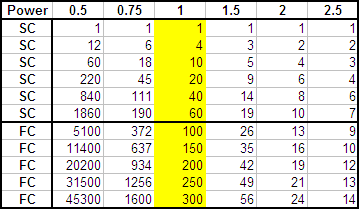
If that doesn’t make a lot of sense then please read our explanation of the Adaptive Moving Average. A total of 960 different averages were tested and each one was run through 300 years of data across 16 different global indexes (details here).
Download A FREE Spreadsheet With Raw Data For
Fractal Dimension Adaptive Moving Average – Modifying Alpha by Raising to a Power
Kaufman had a theory that by squaring Alpha and thus causing the AMA to slow rapidly when the data lacked a strong trend he would achieve better results. When we tested this theory on the ER-AMA we found it to be false but with a different VI we may reach a different conclusion. So lets look at the affect of raising Alpha to different powers:
Fractal Dimension – AMA, Alpha to the Power of 1 – Annualized Return
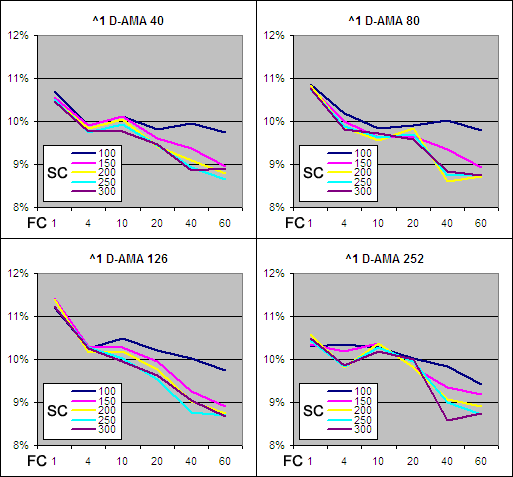
With Alpha ^1 there is no modification to Alpha at all. Clearly as the FC is increased the returns decline and as the FC gets higher the change in SC has more impact. Generally it appears as though a SC of 100 is best on a D-AMA with an unmodified Alpha. ER lengths of 80 and 126 yielded the best returns, this finding is similar to that of our previous tests on other ‘intelligent’ moving averages.
Fractal Dimension – AMA to the Power of 2 – Annualized Return
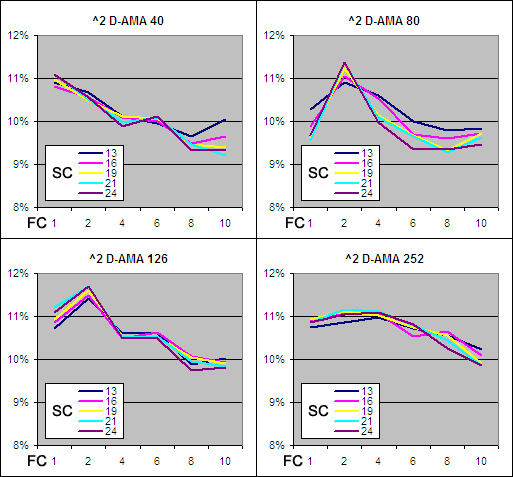
By raising Alpha to the power of 2, returns at almost all the data points increased which is just the opposite of what we experienced when testing the ER-AMA. This shows that Kaufman’s theory of rapidly slowing the AMA during times where a trend is lacking had merit but is dependent on the VI being used.
The best results again came from ER lengths of 80 and 126 although an ER length of 40 did produce some notable returns. Changing the SC did not have as much of an effect with Alpha ^2 compared to Alpha ^ 1 however a SC of 24 (SN equivalent of 300) and a short FC tends to produce the best results. So lets rework the charts to focus on what we now know works best:
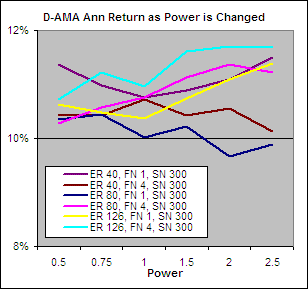
Now we are only looking at ER periods of 40, 80 and 126 with a FN of 1 and 4 and a SN of 300. Each data point plots the change in returns with Alpha raised to different powers. As you can see, the best returns resulted from an ER period of 126 with alpha raised to the power of 2. Therefore when using the Fractal Dimension in an Adaptive Moving average you are best to square alpha as suggested in the original formula..
Best EOD Fractal Dimension Adaptive Moving Average
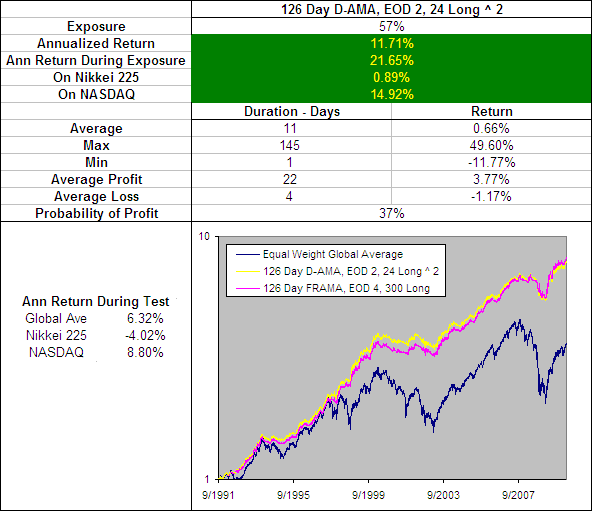
I have included on the above chart the performance of the 126 Day FRAMA, EOD 4, 300 Long becuase so far this has been the best performing Moving Average. The 126 Day D-AMA, EOD 2, 24 Long ^ 2 put up a good fight against the FRAMA but ultimately underperformed by most measures to a small degree. On the Short side, the the D-AMA also underperformed slightly.
126 Day D-AMA, EOD 2, 24 ^ 2 – Smoothing Period Distribution
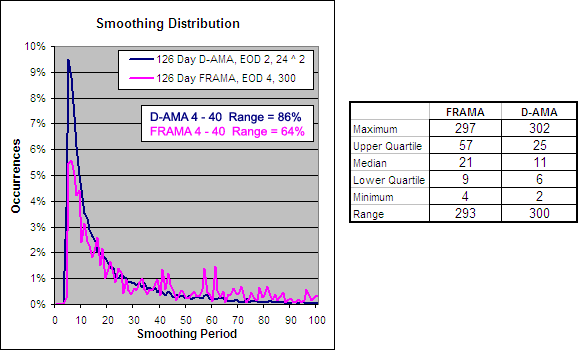
Looking at the smoothing distribution you can see the 126 Day D-AMA, EOD 2, 24 ^ 2 is very similar to that of the 126 Day FRAMA, EOD 4, 300 but the FRAMA allows the average to slow down more often.
126 Day D-AMA 2, 24 ^ 2 – Alpha Comparison
To get an idea of the readings that created these results we charted a section of the alpha for the 126 Day D-AMA 2, 24 ^ 2 and compared it to the best performing FRAMA and the best D-VMA to see if there were any similarities that would reveal what makes a good volatility index:.
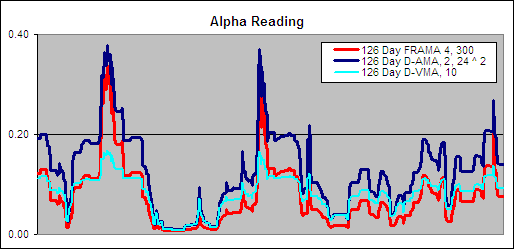
You can clearly see that all three use the same VI, the only difference is how they manipulate Alpha. Remember, higher readings result in a faster average so the D-AMA is obviously the fastest of the three while the FRAMA appears to shift through the widest range.
Best EOW Fractal Dimension Adaptive Moving Average
There are times when an average with a longer trade duration better suits ones needs so we also ran the tests looking for the best average using EOW signals, here is the one that came out trumps:
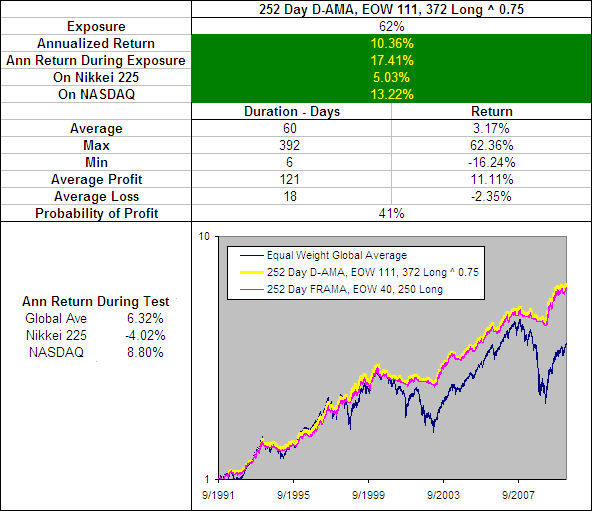
We have included on the above chart the performance of the 252 Day FRAMA, EOW 40, 250 Long becuase so far this has been the best performing EOW Moving Average. The 252 Day D-AMA, EOW 111, 372 Long ^0.75 is almost identical to the FRAMA but does outperform it by a fraction. They are so similar in fact that they may as well be the same average. Performance on the short side tells the same story.
252 Day D-AMA, EOW 111, 372 ^ 0.75 – Smoothing Period Distribution
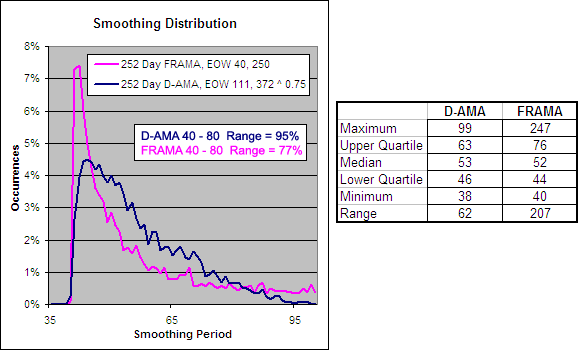
The smoothing distribution for the 252 Day D-AMA 111, 372 ^ 0.75 has a smaller range than that of the 252 Day FRAMA 40, 250 but the median, lower quartile and minimum are almost identical. You can view an Alpha Comparison Here.
Conclusion
In our tests on the ER-AMA we came to the conclusion that the squaring of alpha as suggested in the standard AMA formula was actually detrimental to performance. However when using the Fractal Dimension as the VI, squaring Alpha was beneficial. Therefore the best Power to use in manipulating alpha varies depending on the VI in use.
Overall the D-AMA produced results that were near identical to that of the FRAMA but the D-AMA is a slightly faster average. The best performing EOD D-AMA was the 126 Day ER-AMA, EOD 2, 26 ^ 2 while the best EOW or ‘slower’ moving average was the 252 Day D-AMA, EOW 111, 372 ^ 0.75.
It is very difficult to pick between the FRAMA and the D-AMA but becuase the FRAMA offers a slightly longer trade duration it the best Moving Average we have tested so far.
Want to use this indicator? Get a free Excel spreadsheet at the flowing link under Downloads – Technical Indicators: Adaptive Moving Average (AMA). It will automatically adjust to your choice of many different VIs including the Fractal Dimension used in this article.
For more in this series see – Technical Indicator Fight for Supremacy
- ~ An entry signal to go long (or exit signal to cover a short) for each average tested was generated with a close above that average and an exit signal (or entry signal to go short) was generated on each close below that moving average. No interest was earned while in cash and no allowance has been made for transaction costs or slippage. Trades were tested using End Of Day (EOD) and End Of Week (EOW) signals on Daily data. Eg. Daily data with an EOW signal would require the Week to finish above a Daily Moving Average to open a long or close a short while Daily data with EOD signals would require the Daily price to close above a Daily Moving Average to open a long or close a short and vice versa.
- We used the average annualized return of the 16 markets during the testing period. The data used for these tests is included in the results spreadsheet and more details about our methodology can be found here.



